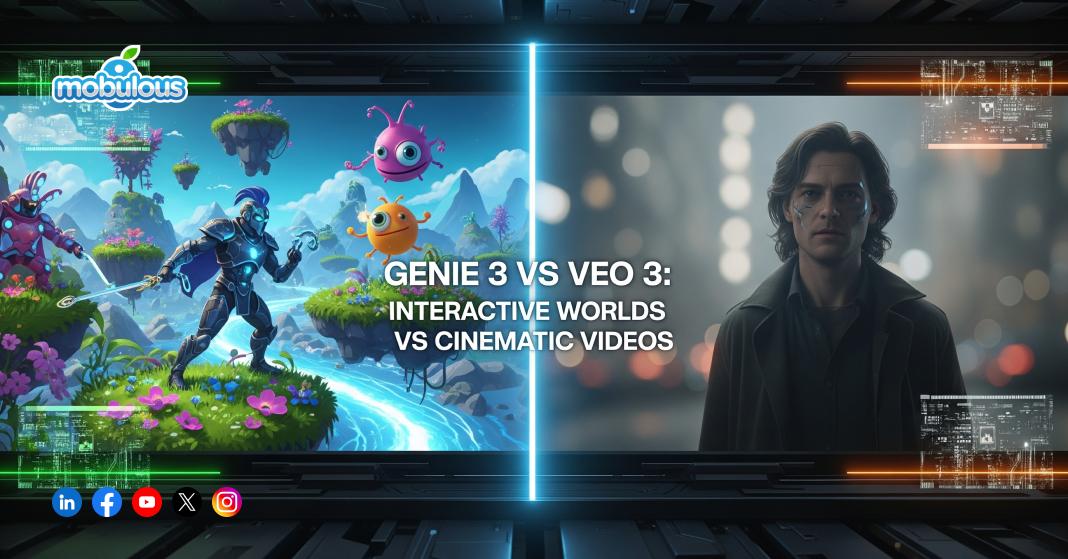Overview of Genie 3 & Veo 3
Genie 3 and Veo 3 are groundbreaking models from Google DeepMind, each serving very different purposes in the AI space. Genie 3 focuses on generating interactive worlds in real-time, while Veo 3 specializes in producing cinematic-quality video and audio content with unmatched realism. Together, they represent major leaps in simulation and creative storytelling.
Unlock the full potential of Genie 3 and Veo 3 by partnering with a top-tier AI & ML development company to drive your next-generation projects.
Feature Comparison of Genie 3 & Veo 3
| Features | Genie 3 | Veo 3 |
| Core Purpose | Interactive Worlds | Video Generation |
| Real-time Speed | 24 FPS | Pre-rendered 4K |
| Consistency | Minutes Memory | Scene Fidelity |
| Interactivity | Navigation + Prompts | Camera Controls |
| Output Type | 720p Interactive | 4K Cinematic |
| Audio | None | Native Generation |
This table highlights the primary distinctions between Genie 3 and Veo 3: Genie 3 emphasizes dynamic, prompt-based navigation in real-time, while Veo 3 emphasizes cinematic quality with audio and visual storytelling tools.
Read more: Genie 3 Explained: Features, Uses, Everything You Need to Know!
Genie 3 vs Veo 3: A Detailed Comparison
1. World Simulation
Genie 3 is purpose-built to simulate environments in real time, allowing users to navigate landscapes and interact with them as if they were inside a game. Veo 3 focuses instead on producing structured, non-interactive video sequences, giving creators complete control over final cinematic quality.
2. Visual Quality
When it comes to output, Genie 3 maintains 720p resolution to achieve real-time interactivity. Veo 3 raises the bar for visual fidelity, delivering high-resolution 4K outputs designed to look as close to reality as possible. This makes Veo 3 more appealing for film and creative industries.
3. Consistency
Genie 3 ensures world consistency for several minutes, preserving memory across revisited areas. Veo 3, while not interactive, excels at consistency across frames, delivering fluid transitions and accurate physics. In Genie 3 vs Veo 3, consistency plays out differently depending on whether the focus is exploration or storytelling.
4. Audio Capabilities
Genie 3 is silent, like it models the visual and physical aspects of the world, but does not yet support sound. Veo 3, by contrast, introduces synchronized audio, from ambient noise and dialogue to environmental sounds. This makes Veo 3 stand out for storytellers needing full multimedia experiences.
5. Control Options
Genie 3 offers promptable world events and navigation inputs to change and explore environments. Veo 3 provides fine-grained camera and motion controls, character references, and even object addition or removal. In short, Genie 3 focuses on interaction inside worlds, while Veo 3 focuses on precise production control.
Pros & Cons of Genie 3 & Veo 3
| Features | Genie 3 Pros | Genie 3 Cons | Veo 3 Pros | Veo 3 Cons |
| Purpose | Agent Training | Not Cinematic | Filmmaking | No Interactivity |
| Resolution | 720p Smooth | Lower Detail | 4K Quality | Heavy Compute |
| Audio | Visual Only | No Audio | Audio Sync | Sync Issues |
| Consistency | Minute Memory | Limited Time | Stable Scene | Static Worlds |
| Control | Prompt Events | Limited Actions | Full Control | Non-Explorable |
This side-by-side view clarifies Genie 3 vs Veo 3 trade-offs. Genie 3 shines in interactivity and research applications, while Veo 3 dominates in cinematic realism and production-level features.
Genie 3 or Veo 3: Which One Should You Choose?
Choosing between Genie 3 and Veo 3 depends on what you need. If you want interactive environments where you can simulate agents, test navigation, or explore AI research, Genie 3 is the clear winner. Its real-time adaptability makes it ideal for experiments in robotics, open-ended learning, and embodied agent research.
If your goal is visual storytelling, whether filmmaking, advertising, or creative content, then Veo 3 is unmatched. With its 4K visuals, synchronized audio, and fine-grained creative controls, Veo 3 is made for producing professional-level media. It doesn’t offer interactivity, but it excels at realism and fidelity.
Ultimately, in the Genie 3 vs Veo 3 debate, the decision is not about which is better overall but which is better for your purpose. Both are transformative tools, but each is optimized for very different kinds of innovation.
Read more: What is Google Veo 3? Everything You Need to Know in 2025
Conclusion
Genie 3 vs Veo 3 illustrates two sides of AI innovation: one focused on live, interactive simulations and the other on cinematic, production-ready content. Genie 3 is a breakthrough for real-time world modeling, while Veo 3 redefines generative video creation. Together, they showcase how AI can shape both research and creative industries.
To bring your AI-powered ideas to life, team up with a skilled web app development company to create intuitive and impactful digital solutions.
FAQs – Genie 3 vs Veo 3
Q1. What is the main difference between Genie 3 and Veo 3?
The main difference lies in purpose: Genie 3 is designed for real-time interactive environments, while Veo 3 is for high-fidelity video production. Genie 3 supports agent research and simulations, while Veo 3 helps creators produce cinematic 4K content with synchronized audio.
Q2. Can Genie 3 generate videos like Veo 3?
Not exactly. Genie 3 outputs real-time environments at 720p for interaction, but doesn’t focus on cinematic quality. Veo 3, however, specializes in rendering pre-generated videos at 4K with stunning realism and audio. Both differ in intent, with Genie 3 simulating worlds and Veo 3 creating films.
Q3. Does Veo 3 support real-time interactivity like Genie 3?
No. Veo 3 is built for video generation, not real-time simulation. It provides creative controls like camera paths and character consistency, but lacks interactive navigation. Genie 3, in contrast, offers real-time inputs and world events, making interactivity its core strength.
Q4. Which one is better for AI agent research?
Genie 3 is better suited for agent research. It allows navigation, world events, and real-time consistency, making it ideal for testing embodied agents. Veo 3 is more about storytelling and video production, so it doesn’t provide the same experimental value for researchers.
Q5. Can Veo 3 generate audio automatically?
Yes. Veo 3 can generate synchronized sound effects, ambient noise, dialogue, and even orchestral scores to match its visual outputs. Genie 3 currently does not support audio and is focused solely on generating interactive, visually consistent environments.
Q6. Should I use Genie 3 or Veo 3 for creative projects?
If your project involves filmmaking, storytelling, or visual media production, Veo 3 is the better choice because of its 4K output and audio generation. Genie 3 is more suited for interactive simulations, so unless your creativity revolves around simulated environments, Veo 3 is ideal.
































